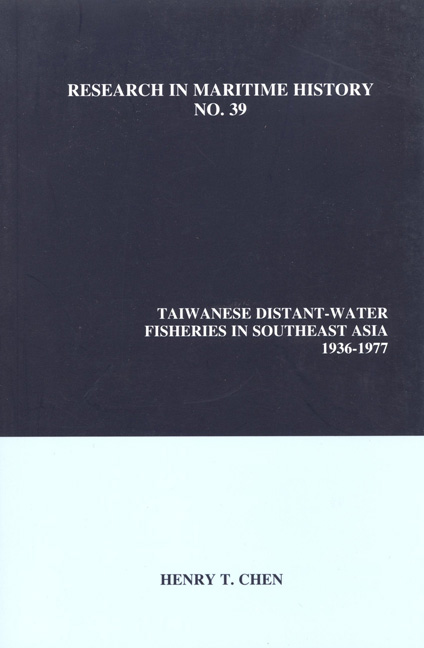Book contents
- Frontmatter
- Contents
- List of Tables
- List of Illustrations
- Notes on the Sources
- About the Author
- Acknowledgements
- Introduction
- Chapter 1 Japan and the Development of Taiwan's Fishing Industry
- Chapter 2 The Revival of the Fishing Industry in Postwar Taiwan
- Chapter 3 Kaohsiung Fishing Port and Its Fishing Ancillary Industries
- Chapter 4 The Taiwanese Fishing Industry and the Military-Political Complex
- Chapter 5 The Kaohsiung Fishing Industry and Its Ancillary Industries
- Chapter 6 The Development of Kaohsiung's Fishing Companies
- Chapter 7 Daily Lives at Sea, Fishing Zones and Politics
- Chapter 8 The Culture and Daily Life of the Kaohsiung Fishing Communities
- Chapter 9 The 1970s Crisis in the Taiwanese Fishing Industry
- Conclusion
- Appendix 1 List of Informants
- Select Bibliography
Chapter 8 - The Culture and Daily Life of the Kaohsiung Fishing Communities
- Frontmatter
- Contents
- List of Tables
- List of Illustrations
- Notes on the Sources
- About the Author
- Acknowledgements
- Introduction
- Chapter 1 Japan and the Development of Taiwan's Fishing Industry
- Chapter 2 The Revival of the Fishing Industry in Postwar Taiwan
- Chapter 3 Kaohsiung Fishing Port and Its Fishing Ancillary Industries
- Chapter 4 The Taiwanese Fishing Industry and the Military-Political Complex
- Chapter 5 The Kaohsiung Fishing Industry and Its Ancillary Industries
- Chapter 6 The Development of Kaohsiung's Fishing Companies
- Chapter 7 Daily Lives at Sea, Fishing Zones and Politics
- Chapter 8 The Culture and Daily Life of the Kaohsiung Fishing Communities
- Chapter 9 The 1970s Crisis in the Taiwanese Fishing Industry
- Conclusion
- Appendix 1 List of Informants
- Select Bibliography
Summary
As the fishing centre of southern Taiwan, Kaohsiung after the war attracted fishing migrants from Penghu, Siao Liouciou and other parts of the island. Hence, Kaohsiung offers a good opportunity to observe their migrant experiences and how socio-cultural factors like kinship and ethnic boundary maintenance affected their job prospects. Various fishing communities engaged in different kinds of fisheries-related activities. Therefore, I will examine both the spatial distribution of their economic activities and how the introduction of new fishing gear transformed the activities of fishing villages. As long-distance fishers, Taiwanese men were frequently away from home. In this context, it is interesting to explore how they managed to find wives and, after they were married, the kinds of marital problems that occurred when fishers were away for extended periods. Also of great importance is the fact that various types of fisheries offered different terms of employment. In the last section of this chapter I will illustrate the personal nature of the relationship between vessel owners and fishers and compare the employment and welfare practices in the different fishing sectors.
Migration, Job Seeking and Ethnic Boundaries
The Penghu Islands comprise several impoverished specks off the southwest coast of Taiwan (see figure 8.1). Traditionally, women and children remained onshore and worked the parched land which could only produce peanuts, sorghum, sweet potatoes, sponge gourds and aloes. The lack of agricultural productivity and sustainable natural resources drove Penghuan men to make a living on the sea. Hence, in terms of the gender division of labour, men worked at sea, while women worked on shore. The Penghuans called this cultural- ecological pattern “half mountain, half sea.”
The abundant marine resources of the Taiwan Strait, however, did not really contribute significantly to their economic improvement since the population was so small that the supply of fish always exceeded local demand. The more fish they harvested, the poorer their families became as the price declined. Hence, some Penghuans were forced to be seasonal fishers, oscillating back and forth between Kaohsiung and Penghu every year, while others migrated directly to Kaohsiung. The first wave of Penghuan migrants came mainly from Cimei. They began their migration during the colonial period and in general preferred to settle in Cihou rather than Gushan.2
The economy in Siao Liouciou was worse than in Penghu.
- Type
- Chapter
- Information
- Taiwanese Distant-Water Fisheries in Southeast Asia, 1936–1977 , pp. 143 - 166Publisher: Liverpool University PressPrint publication year: 2009



